|
< Earlier Kibitzing · PAGE 26 OF 29 ·
Later Kibitzing> |
| Oct-06-09 | | timhortons: Movsesian vs I Papaioannou, 2002 there's 3 game on scandinavian that kaufman discuss in his book and he thoroughly analyze it, here's on of my favorite ,playing on white stand point. |
|
| Oct-08-09 | | Robin01: Recent OTB game.
[White "Robin01"]
[Black "NN"]
[TimeControl: "40/2hr, G/1hr"]
1. e4 d5 2. exd5 Nf6 3. d4 Nxd5 4. c4 Nb6 5. Nf3 Bg4 6. Be3 e5 7. Be2 Bb4+
8. Nc3 Nc6 9. d5 Bxf3 10. Bxf3 Ne7 11. Qc2 Qd7 12. a3 Bxc3+ 13. Qxc3 Qf5
14. a4 O-O 15. O-O Nd7 16. h3 Qg6 17. b4 f5 18. Bc5 Nxc5 19. bxc5 e4 20.
Bd1 f4 21. Kh1 Rf5 22. Rg1 Rg5 23. Bg4 Rf8 24. Be6+ Kh8 25. Rae1 Nf5 26.
Bxf5 Qxf5 27. Qd4 Rh5 28. Kh2 Re8 29. g4 fxg3+ 30. Rxg3 Qe5 31. Rxe4 Rxh3+
32. Kxh3 Qf5+ 33. Rgg4 Qf3+ 34. Kh2 Rg8 35. Qxg7+ 1-0 |
|
| Oct-09-09 | | Robin01: Anybody have any thoughts on this variation for black -- 5...Nd5 is more common. I have not seen too many games where black plays the knight back. There are also not too many games in any database on this line.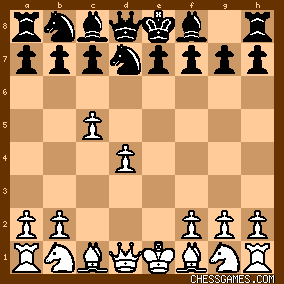
click for larger view |
|
| Oct-09-09 | | Robin01: <<The Chess Express> I'd like to post a line here that is not covered by the opening explorer. It goes 1. e4 d5 2. exd5 Qxd5 3. Nc3 Qa4 <4. f4!?> How about an immediate 4...e5 by black? |
|
| Oct-10-09 | | The Chess Express: Hi <Robin01>. I've analyzed two lines. Check my forum for some games courtesy of <whiteshark> <A> 1. e4 d5 2. exd5 Qxd5 3. Nc3 Qa5 4. f4 e5 5. Nf3 exf4 6. d4 g5 7. Bc4 Bg4 8. Qe2 Ne7 9. Bxf7+ Kxf7 10. Ne5 Kf6 11. Nxg4+   
click for larger view<B> 1. e4 d5 2. exd5 Qxd5 3. Nc3 Qa5 4. f4 e5 5. Nf3 exf4 6. d4 <Bd6> 7. Bd3 Nf6 8. 0-0 0-0 9. Nb5  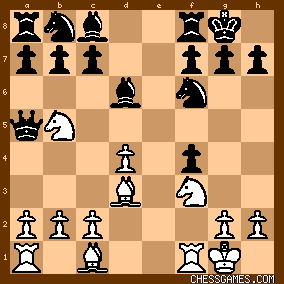
click for larger view |
|
Oct-10-09
 | | An Englishman: Good Morning: The lines offered in the analysis of 1.e4,d5; 2.exd5,Qxd5; 3.Nc3,Qa5; 4.f4 look rather accommodating to the White pieces. f4 does nothing for development and blocks the Bc1, so even an old obsolete idea might work for Black: 4...Nf6; 5.Nf3,Bg4!?; 6.h3,Bxf3; 7.Qxf3,c6. The Bc1 will soon wish the f4 pawn wasn't in the way, esp. if White plays d2-d4. 5...g6 might also work, as Black needn't fear the e4-e5 advance, as in the Pirc. The point is that the absence of the e-pawn takes a lot of the oomph out of the f-pawn advance. |
|
| Oct-10-09 | | The Chess Express: Good afternoon :) I'm a little confused by this statement. <An Englishman: Good Morning: The lines offered in the analysis of 1.e4,d5; 2.exd5,Qxd5; 3.Nc3,Qa5; 4.f4 look rather accommodating to the White pieces.> I simply tried to give black the same solid development that he usually gets in the Scandinavian. It makes sense to develop black’s light ♗ outside the pawn chain, and I believe that f5 is better than g4. I welcome any improvements for black in those lines. <f4 does nothing for development and blocks the Bc1, so even an old obsolete idea might work for Black: 4...Nf6; 5.Nf3,Bg4!?; 6.h3,Bxf3; 7.Qxf3,c6. The Bc1 will soon wish the f4 pawn wasn't in the way, esp. if White plays d2-d4. 5...g6 might also work, as Black needn't fear the e4-e5 advance, as in the Pirc. The point is that the absence of the e-pawn takes a lot of the oomph out of the f-pawn advance.> Lets take a look at the basic pawn structure.

click for larger viewThe idea of playing 4. f4 is to control e5, gain space on the kingside, and set up a minority attack there if possible. White is not concerned with f4 blocking the dark ♗. f4 establishes an outpost for the knight on e5, and it oftentimes advances to attack e6 anyway. The ideal setup would be for white to fianchetto the dark ♗ on b2 ah la Bird’s opening, but with black’s ♕ on a5 that’s not as easy because after b3 black can oftentimes play Ba3 killing some of that “oomph” that you mentioned. The other side of the coin is that with the black ♕ on a5 d2 becomes a descent square for the ♗, and in fact it often goes there all the same in the traditional main lines where white does not play an early f4. Lets have a look at the plans for black that you mentioned. First <4...Nf6; 5.Nf3,Bg4!?; 6.h3,Bxf3; 7.Qxf3,c6> In this line I prefer to simply play the modest looking 6. Be2. The idea is to give black nothing from trading ♗ for ♘, and if black does not trade then the ♘ is free to go to e5 while the ♗ gets kicked around all over the kingside. Here are a couple of lines. 1. e4 d5
2. exd5 Qxd5
3. Nc3 Qa5
4. f4 Nf6
5. Nf3 Bg4
6. Be2 <e6> (black allows Ne5)
7. Ne5 Bxe2
8. Qxe2 Nd7
9. d4 Be7 (Bb4 probably helps white)
10. Bd2 c6
11. O-O-O Qc7
12. g4 O-O (f7 needs to be protected)

click for larger viewWhite’s attacking prospects are obvious.
1. e4 d5
2. exd5 Qxd5
3. Nc3 Qa5
4. f4 Nf6
5. Nf3 Bg4
6. Be2 <Nd7> (black challenges e5)
7. h3 Bxf3
8. Bxf3 c6
9. d4 e6
10. Qd3 Bb4
11. Bd2 Nd5
12. O-O O-O
13. a3 Bxc3
14. bxc3 Qc7
15. Rb1
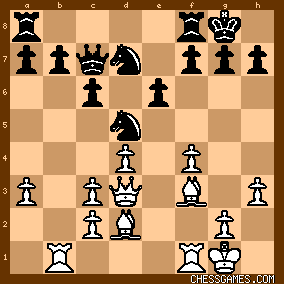
click for larger view White is ready to shift the attack to the queenside. White is probably better in the center and on both sides of the board. Black is solid, but with the extra space and the two ♗'s white is probably better. |
|
| Oct-10-09 | | The Chess Express: <An Englishman: 5...g6 might also work, as Black needn't fear the e4-e5 advance, as in the Pirc. The point is that the absence of the e-pawn takes a lot of the oomph out of the f-pawn advance.?> Now lets take a look at the second plan you offered.
1. e4 d5
2. exd5 Qxd5
3. Nc3 Qa5
4. f4 Nf6
5. Nf3 <g6> (A relatively sound idea. I like this better than Bg4, but still not as much as the Bf5 lines I posted earlier)
6. Ne5 Nd7
7. d4 Bg7
8. Bc4 O-O
9. O-O c5
10. Be3 Nxe5
11. dxe5 Ng4
12. Bd2
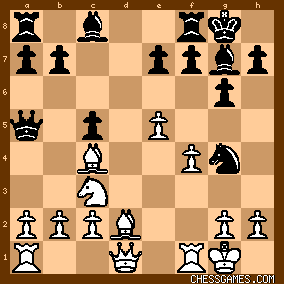
click for larger view White has more space, better development, and black's dark ♗ is shut in all the same by a ♙ on e5. All in all I would still rather have these positions than a main line. They are solid and offer white decent attacking possibilities. |
|
| Oct-11-09 | | The Chess Express: <Robin01: How about an immediate 4...e5 by black?> I've taken a closer look at this and have decided that after the moves 1. e4 d5 2. exd5 Qxd5 3. Nc3 Qa5 4. f4 e5 white probably does better to play <5. Qh5>. A quick run through with Fritz 8 gives 5. Qd1-h5 Nb8-d7
6. Bf1-c4 <g7-g6>
7. Qh5-e2 f7-f6
8. f4xe5 Qa5xe5
9. Nc3-b5 Qe5xe2+
10. Ng1xe2 Bf8-d6
11. O-O Ng8-e7
12. Nb5xd6+ c7xd6
13. Ne2-c3 Nd7-b6
14. Bc4-b3 (+1.56)
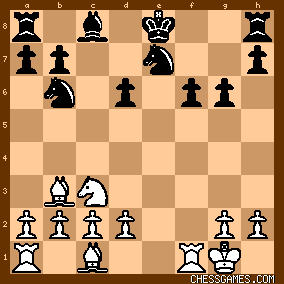
click for larger view5. Qd1-h5 Nb8-d7
6. Bf1-c4 <Ng8-h6>
7. Qh5-e2 Bf8-b4
8. Ng1-f3 O-O
9. f4xe5 Rf8-e8
10. O-O Nd7xe5
11. d2-d4 Ne5xf3+
12. Qe2xf3 Nh6-f5
13. g2-g4 Qa5-b6
14. Kg1-h1 Qb6xd4
15. Bc4-b3 (+1.92)

click for larger viewThese are low ply checks, but the analysis looks good to me. |
|
| Oct-31-09 | | timhortons: http://gameknot.com/mt.pl?id=40718
A thematic mini-tournament about the Scandinavian Defense (also known as Center Counter Defense) 11 players to play. |
|
| Oct-31-09 | | timhortons: The old move 2...Qxd5 is considered weak ... The modern way is 2...Nf6. Then White has the choice of either 3.c4 or 3.Bb5+ to hold the Pawn, or simply 3.d4. Against Bergrasser at Monaco 1967, I chose 3.Bb5+ Bd7 4. Bc4 Bg4 5. f3 Bf5 (safer is ...Bc8) 6. g4! Bc8 7. Nc3 Nbd7 8. g5 Nb6 9. Bb5+ Nfd7 10. f4 Nxd5 11. Nxd5 c6 12. Bc4 cxd5 13. Bxd5 and White's extra pawn should prevail.
---Bobby Fischer
but still Qxd5 is played again and again and again by this rybka generation. |
|
| Oct-31-09 | | The Chess Express: 1. e4 d5
2. exd5 Nf6
3. d4 Nxd5
4. c4 Nb6
5. Nf3 Opening Explorer
click for larger viewThis line has all but been refuted by white. The modern view is that 2. exd5 Qxd5 is better. Personally, I like to play 1. e4 d5
2. exd5 Nf6
3. d4 Bg4 Opening Explorer 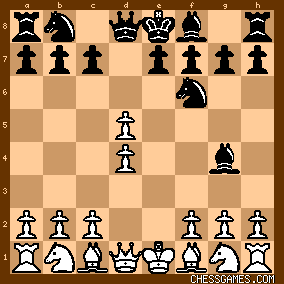
click for larger viewIf white plays 4. f3 here then he is probably busted. White can avoid this line with 1. e4 d5
2. exd5 Nf6
<3. Nf3> Bg4
4. Bb5+
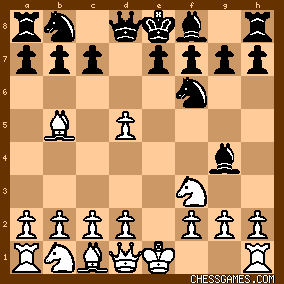
click for larger view
when black is probably just down a pawn. After 3. Nf3 I revert back to the old main lines with 3...Qxd5. 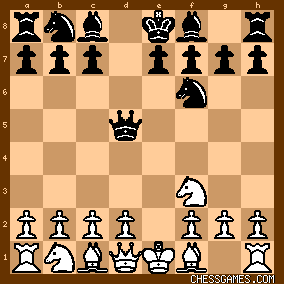
click for larger viewHaving avoided the dangerous 4. f4 lines that I've analyzed I feel comfortable with black's position. Don't laugh, but I actually looked at 1. e4 d5
2. exd5 Nf6
<3. f4?!> Nxd5
4. g3 Bf5
5. Nf3 e6
6. Bg2 Be7

click for larger viewAs you may have guessed black has an edge here. As long as I can avoid the 1. e4 d5 2. exd5 Qxd5 3. Nc3 Qa5 4. f4 lines I'm happy to play the Scandinavian. |
|
| Oct-31-09 | | SirChrislov: <TheChessExpress>
There's an instructive 2... Nf6 3.d4 Bg4 (known as portuguese variation or Jadoul gambit) game in my profile you might like to look at. that's a funny lookin position you reached on that f4 line. I've never seen it before. <sorry, I couldn't help but laugh a little> but yeah, blk looks better to me. nice reaserch. |
|
| Oct-31-09 | | MaxxLange: <timhortons> Fischer's opinion on theory is always valuable, but it's important to remember that he wrote that, what, four decades ago? The 2...Qxd5 players had rehabilitated their system by the '80s or '90s, iirc. personally, I do find 2...Nf6 harder to play against. |
|
| Oct-31-09 | | timhortons: <MaxxLange:>
thanks, im really new on these, im trying to pick up any valuable info i could. |
|
| Oct-31-09 | | MaxxLange: <timhortons> oh come on, you seem like probably know more about chess than I do all I am saying is, it isn't just Rybka that keeps 2...Qxd5 going. The Fischer quote was very interesting and detailed. |
|
| Oct-31-09 | | timhortons: <MaxxLange:> i play at gameknot.com, i rely only to databse on my moves, then try to become familiar to the game pattern. its only when i see in person GM tiviakov last few months ago that i got interested with scandinavian. |
|
| Oct-31-09 | | MaxxLange: I see. Sorry, I took your meaning wrong. |
|
| Nov-01-09 | | Manic: <TCE> I want to look at the risky looking 1.e4 d5 2.exd5 Qxd5 3.Nc3 Qa5 4.f4 e5 5.Qh5 Nc6 The point is that black isn't as worried about the queen trap because of the pawn on e5 preventing d4 for now, while d3 can only be played after Bc4 and isn't as ambitious. Also, it protects the queen so ...exf4 becomes an option. A few lines:
a) 6.Bb5 is the key here I guess. I am looking at 6...Bd7. 7.fxe5 0-0-0 is suggested by our mutual friend Fritz, who I asked after realising my other suggestion for move 7 was bogus. It thinks that this gambit looks pretty good, and the reason is because the knight is on c6 and the queen is off wandering Nb4 or d4 is annoying. A sample line is 8.Qxf7 Nh6 9.Qf4 Nb4 10.Bxd7+ Rxd7 11.Kd1 and black's compensation is fairly obvious. Way ahead in development and white's king in the middle. 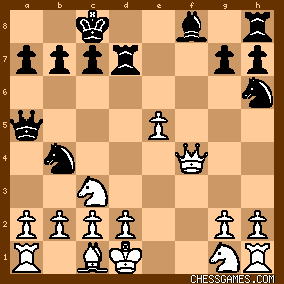
click for larger viewThe other line Fritz puts in favour for white is 8.Bxc6 Bxc6 in anticipation that the knight will be annoying. 9.Nge2 f6 10.d4 fxe5 and whichever way white takes back, although black is down a pawn there is enough activity to suggest that there is compensation for black. The e pawn is weak and black has the bishop pair in addition to better placed pieces. 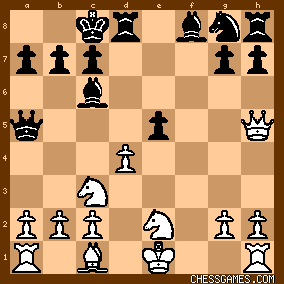
click for larger viewPosition after 10...fxe5
b) 6.Bc4 g6 7.Qd1 isn't looking any good (if anything else 7...Nd4 looks annoying). c) 6.d3 is rubbish
Improvements are welcome as the idea of 0-0-0 was computer's idea not mine (I did think of it but probably didn't want to go down another pawn. For some reason I like 1 pawn gambits but not 2 pawn ones). This analysis has been brought to you by Chessbase 7.0 and Fritz 8. Don't have the wits? Try Fritz. Giving brains a break for over 15 years. Manic is not associated with ChessBase or Fritz in any way. |
|
| Nov-01-09 | | The Chess Express: <Manic: <<<<TCE>>>> I want to look at the risky looking 1.e4 d5 2.exd5 Qxd5 3.Nc3 Qa5 4.f4 e5 5.Qh5 Nc6 b) 6.Bc4 g6 7.Qd1 isn't looking any good (if anything else 7...Nd4 looks annoying).> Try this line.
7. Qh5-e2 Ng8-e7
8. Ng1-f3 Bf8-g7
9. f4xe5 Nc6xe5
10. Bc4-b5+ Ne5-c6
11. Bb5xc6+ b7xc6
12. O-O Bc8-e6
13. d2-d3 Bg7xc3
14. b2xc3 Qa5xc3
15. Bc1-f4 O-O
16. Nf3-g5 Qc3-d4+
17. Kg1-h1 Qd4-d7
18. Ng5-e4 (+1.68)

click for larger view<Manic: 6.Bb5 is the key here I guess. I am looking at 6...Bd7. 7.fxe5 0-0-0> That's a wonderful gambit idea. I don't have the time now, but tonight I'll look at this more closely. My Fritz says that 6. Bc4 Nh6 may be a better option for black. Thanks for bringing this to my attention. |
|
| Nov-01-09 | | The Chess Express: <Manic> What does your Fritz say about this line? 1. e2-e4 d7-d5
2. e4xd5 Qd8xd5
3. Nb1-c3 Qd5-a5
4. f2-f4 e7-e5
5. Qd1-h5 Nb8-c6
6. Bf1-b5 Bc8-d7
7. f4xe5 O-O-O
8. Bb5xc6 Bd7xc6
9. Ng1-f3 g7-g6
10. Qh5-g4+ Kc8-b8
11. O-O Bc6xf3
12. Qg4xf3 Qa5xe5
13. d2-d3 f7-f5
14. Bc1-f4
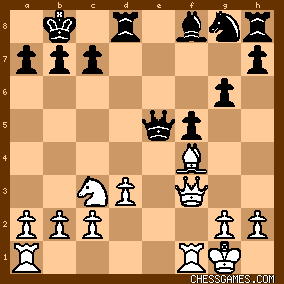
click for larger viewMine says it's equal, but then I keep getting winning lines for white. White has a nice lead in development. Oh well, back to work. |
|
| Nov-01-09 | | Manic: <TCE> Thanks for the reply. Sorry I didn't include more analysis I probably should have looked at these two lines. For some reason they did not cross my mind. In regards to your first line, I found another gambit (courtesy of the computer of course). I didn't see that after 7.Qe2 Nd4 white can play 8.Bb5+. I hence entered 7...Bd7 in to stop the check and try to get some sort of transposition into the other line: 7.Qe2 Bd7 8.Nf3 0-0-0 9.Nxe5 Nd4 10.Qd1 Nh6 and leaving fritz for about a minute the evaluation becomes even. 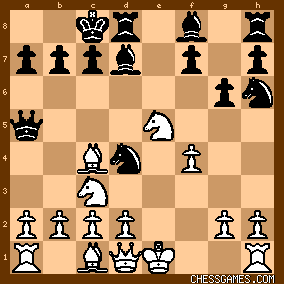
click for larger viewA deviation from this might be the immediate 8.fxe5. Again black plays 8...0-0-0 9.e6 and so there is three choices of fxe6, Bxe6 and Re8. Funnily enough, the most inhuman choice of fxe6 comes up as dead equal after leaving Fritz for 3 minutes, but I don't see that as viable at all. It just doesn't look right so I will leave it. 9...Re8 10.exd7+ Kxd7 11.Ne4 f5 12.Bd3 Nd4 Bg7
[bad FEN: 4rbn/pppk2bp/6p1/q4p2/3nN3/3BQ3/PPPP2PP/R1B1K1BN]
And here fritz likes black. The pawn isn't exactly regained as the f-pawn may drop after eventually taking the knight, and black's king is also stuck in the middle for a bit, but quite clearly black's pieces are just so dominant whlie white's are all tied up. OK, since it seems Re8 looks good I might not look at Bxe6, which also ends up with an isolated e pawn and looks bad. <That's a wonderful gambit idea> Thank's for the compliment =). Although Fritz found 0-0-0, I can take credit for Bd7, even if it was initially for the wrong reasons. |
|
| Nov-01-09 | | Manic: Bad FEN should be:
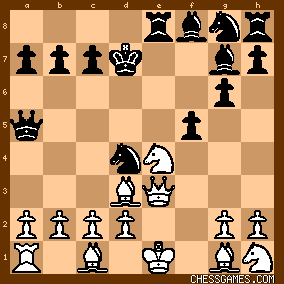
click for larger viewOn your 2nd line, my one likes 9.Bxf3 gxf3, which I know is totally inhuman giving up your greate white-squared bishop but it does discourage white from castling kingside, weakens support for the e-pawn and prevent d4 being played, when white has reinforced the e-pawn and finally let the dark-squared bishop see life.
9.Nf3 Bxf3 10.gxf3 Ne7 11.f4 Nc6 (transfering the other knight to go to d4!). Here Fritz, being a computer, likes to go nabbing pawns with 12.Qxf7, which after 1 min is the only move that lets white even it, since black's knight is going to come to d4 anyway. Thanks to giving up the white-squared bishop though, black has a new resource that works with Nd4. 12.Qxf7 Nd4 13.Kd1 Qa6/c5/b6!?. All of these moves have the same effect. The queen now heads to c6 to take advantage of the lovely diagonal giving up the bishop has left it. 14.Re1 Qc6 15.d3 (right about now Fritz realises white is a dead duck) Qf3+ 16.Ne2 Bb4 
click for larger viewSurely white has better play. Even I can't believe white lost this that fast. In any case this game shows that black does not worry about dropping the pawn, because f4 delays development and so black wants to strike fast. I guess we can view this gambit in the same vein we view the Icelandic and 3.c4 c6 gambits in the 2...Nf6 lines, where c4 delays development. I will take a look at a different line, which is a bit more human but again we tell our kingside pawns that they must be given up. 9...Bc5!?, which is my idea because I want to prevent white from castling. Mr Greedy has two moves which are "good" for white, but very similar. I'll only look at 1 for now, the other being Qg4+ and Qxg7. 10.Qxf7 Ne7 11.Qxg7 (really Fritz? REALLY?) Ng6

click for larger viewLeaving Fritz for a bit tells me only d3 leaves the position equal. Yeh right.... 12.d3 Bxf3 13.gxf3 Nxe5 14.Qg3 Rhg8 15.Qh3+ Kb8
1k1r2r1/ppp4p/q1b1n3/8/2NP1P1Q/PPP4P/R1B1K2R
About here still evaluating as equal, but leaning towards black. I don't think any human in their right mind would prefer white here. White's try to castle with Bd2 meets quite a cute refutation, because computers love tactics even if they are +2.00 material down. 16.Bd2 Nc4! 17.0-0-0 (the knight is poison due to 17.dxc4 Rge8+ 18.Kd1 Be3) Nxd2 18.Kxd2 Bb4 and black goes for the queenside pawns. Evidently it isn't black totally dominating the middlegame but the end result is black has a passer on the a and white passer on the h. However, black's king is safer and pieces are more active, which probably ensures a win for black. Of course, there are many deviations which I have not looked at. In any case, I think we can be almost certain nobody is as crazy as me and will play such a line against f4 unless they look at the board for 10 minutes or something or they somehow prepared for it. 4.f4 is interesting and whether or not it works it looks at least playable. Maybe I will throw it out next time I meet the center-counter, although my results recently against the defence have been alright playing normally, but then again my opponents weren't playing crash hot. I myself am I center-counter player but play 2...Nf6 or 2...Qxd5 and 3...Qe5+!? (I drew a GM in a simul with the latter, although it was probably the most BORING game ever I have played in my entire life, where white has a slight advantage but nothing really happens and it just peters to a drawn endgame). Oh, and 2...Nf6 is relying on my opponents not realising 3.Bb5+ is an option, which I know is actually a reason not to play the opening. I do not play it exclusively against e4 though. Thanks for taking the time to reply so quickly to my initial analysis. Don't feel compelled to answer straight away if you are busy. I don't mind waiting a few days. Looking forward to your reply. |
|
| Nov-02-09 | | The Chess Express: <Manic> I believe that you have found the most challenging response by black. Everything that I've looked at so far in the 6. Bb5 lines has lead to a pretty sterile equality. <Manic: 7.Qe2 Bd7 8.Nf3 0-0-0 9.Nxe5 Nd4 10.Qd1 Nh6 and leaving fritz for about a minute the evaluation becomes even.> This is one line that I'm further exploring. What does your Fritz say about 1. e4 d5
2. exd5 Qxd5
3. Nc3 Qa5
4. f4 e5
5. Qh5 Nc6
6. Bc4 g6
7. Qe2 Bd7
8. Nf3 O-O-O
9. Nxe5 Nd4
10. Qd1 Nh6
11. O-O Bf5
12. Bd3 Bxd3
13. Nxd3 Qf5
14. Ne1

click for larger view |
|
| Nov-02-09 | | The Chess Express: Also, we should probably consider
1. e4 d5
2. exd5 Qxd5
3. Nc3 Qa5
4. f4 e5
5. Qh5 Nc6
6. Bc4 <Nh6> |
|
 |
 |
|
< Earlier Kibitzing · PAGE 26 OF 29 ·
Later Kibitzing> |





